9.2 Seed Physiology
Learning objectives
By the end of this lesson you will be able to:
- Describe the process of seed germination.
- List the external factors that are required for seed germination.
- Understand dormancy and the conditions needed for germination to occur.
Seed — a living plant in a quiescent state
In the ovary, within the ovule, after egg and sperm unite to form the zygote, the zygote cell repeatedly divides and develops into an embryo. The embryo differentiates into different structures — plumule, radicle, cotyledon(s), and the endosperm, seed coat, or pericarp develop. Once this development has occurred, the embryo’s metabolism slows down to nearly zero and the maternal plant stops pumping energy into the seed. The nascent plant contained within the seed — really an embryo surrounded by nutritive tissue and a protective covering — is now independent of the mother plant. The seed, which is the next generation of plant, enters a quiescent phase.
Recall that the seed contains:
- An embryo, which is the new plant,
- A nutrient source (typically endosperm and/or cotyledon), and
- A protective covering (typically a seed coat and/or pericarp)
Why do plants produce seeds? Because seeds allow plants to:
- Propagate the next generation
- Generate genetically variable offspring that can be sorted through natural selection
- Survive harsh conditions
- Disperse into new environments
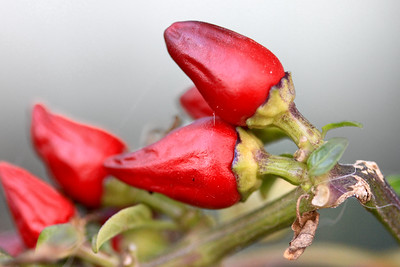
The first of these reasons is obvious, to propagate. One parent plant generates many seeds, and through these seeds potentially bears many offspring. A kidney bean plant, for instance, might average 4 seeds per pod and have 20 pods hanging on the plant, so one plant yields 80 seeds. A nice ear of field corn will have 16 rows of kernels with 40 kernels per row, for a yield of 640 seeds. The tiny hot pepper in your garden has over 50 seeds, and 20 peppers on a plant would yield 1,000 seeds.
The second reason, genetically variable offspring, results from cross-pollination (mentioned above under Seed Morphology), which is particularly common in wild, undomesticated plants. When plants cross-pollinate, an egg is formed within the maternal plant. The genetic constitution of the developing embryo within the seed is 50% from the paternal plant, 50% from the maternal plant. The particular combination of genes in the developing seed is different from that in either parent plant, and from the other seeds on the same maternal parent. The seeds share some of the same genes, but the specific combination of genes is different. That difference results in genetic variability, which can be expressed as differences in plant height, flower color, leaf shape, fruit size, or other morphological or physiological characteristics. In nature, this variability is the raw material on which natural selection operates. In plant breeding, it is the resource that sustains our efforts to select improved plant varieties.
Due to their protective coating and quiescent metabolism, seeds can survive harsh conditions that will kill the parent plant such, as freezing cold, protracted drought, and even fires. Once conditions are again favorable for plant growth, the seeds can then germinate.
Seed dispersal
Watch this video for an explanation of seed dispersal in space and time (2:20)
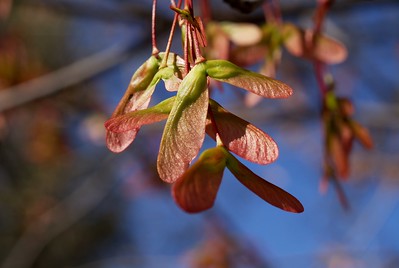
Seeds disperse from the maternal parent plant “in space” through many wonderful and creative mechanisms for hitching rides on the wind, on animals, and sometimes in animals as they are eaten, pass through the gut, and are excreted.
You have probably seen fluffy cottonwood (poplar) seeds floating on the summer breeze, pulled burdock seeds off your sweater after bushwhacking through the woods in the fall, or washed bird guano full of mulberry seeds off your car’s windshield. These seeds all used strategies for dispersal in space. Vanderbilt University’s Bioimages (optional) includes photos of mechanisms that help spatially disperse seeds.
Seeds also disperse from the maternal parent plant “in time.” Some have dormancy mechanisms that delay germination until the next favorable growing season, which might be a year from now or even several years from now. Seeds are considered dormant if they are alive and don’t germinate even if provided with favorable conditions for germination. There are many dormancy mechanisms; we’ll address some of them later.
If you’ve ever dug up new sections of your yard for a garden, did you notice that, a few weeks after planting veggies or flowers in the spring, you saw a big flush of weeds? And if you pulled up all of those weeds and somehow prevented any new seeds from landing in the garden, you still got a big flush of weeds the next year? This is called the soil’s seed bank, and it’s due to dormant seeds that are resting in the soil. Every year a percentage of those seeds lose their dormancy and germinate, leaving you wondering in frustration whether the weeding will ever end. (It won’t.)
- What type of reproduction results in genetic diversity among seeds produced on the same plant?
- Distinguish between mechanisms causing dispersion in time vs. dispersion in space.
- What part(s) of the seed provide nutrition? Protection?
Germination
Germination is the reactivation of the seed’s metabolism and the restoration of embryo growth. There are two main reasons why seeds don’t germinate:
- They could still be quiescent because favorable external conditions do not yet exist. In particular, the environment could be too dry or too cold, or the oxygen levels could be too low to support embryo growth.
- They could be dormant — the characteristic that allows seeds to disperse in time.
External conditions
The external conditions required for germination to occur are:
- Water
- Oxygen
- Temperature
- Light (for some small or fine seeds, like lettuce)
Looking at these external conditions more closely:
Moist conditions allow the seed to imbibe water. Seeds are typically very dry — somewhere in the 8–15% relative humidity range — so they will readily take up moisture from damp soil. Water moves through the pericarp and seed coat into cells and leads to reactivation of the metabolic processes. The seed’s nutritive reserves are metabolized for the embryonic cells to divide, enlarge, and differentiate.
The breakdown of nutrient reserves to form energy for plant growth is called respiration, and it requires oxygen. The seed must have oxygen to respire. If you keep seeds in an oxygen-depleted atmosphere, they will not germinate. One all-too-common type of oxygen-depleted environment in which seeds are sometimes placed is waterlogged soil. If you over-water newly planted seeds, the water will keep oxygen from reaching the seeds, and although the seeds will imbibe water and swell as if everything is going well, they will not germinate, and will likely rot because there is not enough oxygen available to sustain respiration. Waterlogged soil also encourages growth of bacterial and fungal organisms that can infect and decompose the seed.
Depending on the species, seeds have various temperature requirements for germination. Some spring flowers will germinate when soil temperatures are quite cool, even below 50ºF, while most of the seeds we plant in our gardens prefer temperatures in the 50–70ºF range. Again, respiration is the reason. Molecules move around faster when they are warmer, and this movement encourages the chemical reactions required for respiration. If the seeds are cold and the molecules aren’t moving around, the seeds won’t germinate.
If light is required for seed germination, the species is said to be positively photoblastic. This characteristic allows the seed to remain dormant when buried deep underground, but to germinate when brought to the surface. As you might imagine, weeds that are successful in annually-tilled soils may be positively photoblastic. They remain dormant until tillage brings them to the soil surface.
A note about respiration
Respiration refers to the set of reactions that take place in the plant cell to convert chemical energy stored in molecules into a form of energy that can be readily used by the cell to power other chemical reactions. Respiration converts the starch stored in the endosperm or cotyledon into ATP (Adenosine triphosphate) (optional reading), which is used in the apical meristems and the radical of the embryo to fuel cell division and the production of new cells.
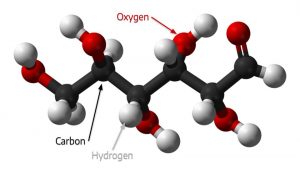
Starch is made up of a chain of glucose subunits. Glucose, shown in the three-dimensional model above, is a simple sugar that is made up of 6 carbon atoms, 6 oxygen atoms, and 12 hydrogen atoms. The shorthand formula for glucose is C6H12O6. The shorthand formula for starch is [C6H12O6]n, where the “n” indicates that there are “n” glucose molecules that, when linked together, make up a starch molecule.
When we put a quiescent, but not dormant, seed in the ground and it has access to appropriate moisture, warmth, and oxygen (and light if positively photoblastic), it begins to respire. Enzymes are secreted by the cotyledon and, depending on the species, by other specialized cells surrounding the cotyledon and endosperm, which break down the stored starch into its glucose subunits. It is important that the starch be broken down to glucose because glucose is a sugar that is physically small enough to pass through the semipermeable cell membrane; starch is too large to get through. Starch can’t be moved from cell to cell, but glucose can. Starch can be stored in cotyledon or endosperm cells and be broken down to glucose, and that glucose then moves into the actively dividing meristem cells.

Once in the cell cytoplasm, the glucose is broken in half by a process called glycolysis to form a 3-carbon compound known as pyruvate. Pyruvate first reacts with a carrier molecule and then moves into the mitochondria — the powerhouse organelles in the cell — where it is further metabolized to yield high-energy molecules of ATP. The processes in the mitochondria require the presence of oxygen. The ATP moves out of the mitochondria and to the parts of the cells where chemical reactions are taking place that need energy.
Starch stored in the seed is a form of stored energy composed of glucose. Glucose is a transportable form of chemical energy that can move through cell membranes, so it helps surround the seed with chemical energy. Pyruvate is a compound formed from glucose that can move into the mitochondria and be broken down to yield ATP. ATP leaves the mitochondria and provides the cell with the energy needed for a wide range of chemical reactions.
The inputs for respiration are glucose and oxygen. Respiration converts the energy stored in the glucose into ATP that will power reactions throughout the cell. Carbon dioxide and water are the two waste products.
Seeds also store lipids and protein in the cotyledons. These too can be broken down during respiration. The lipids are first biochemically deconstructed into their components: glycerol and fatty acids. The glycerol molecule is made up of carbon, hydrogen, and oxygen — so it can also be converted to pyruvate and heads into the mitochondria for conversion to ATP. The fatty acids take a different biochemical route, but still end up yielding ATP. Protein respiration is even more complicated, and yields nitrogen-containing building blocks of protein and cells called amino acids that are used in construction of other molecules in the cell. Stored protein in the seed is better at providing amino acid building blocks than it is in providing ATP to energize the cell. Protein can provide energy if necessary, but starch and lipid are more efficient energy storage molecules.
Storing seeds
Since germinating seeds require oxygen, moisture, and warmth, you can intentionally restrict germination by limiting one or more of these conditions. Why restrict germination? One reason is to store and save seeds for long periods of time. The most common method for storing seeds is to ensure that they remain dry. If you dry seeds in the sun on a low-humidity Minnesota day, you will get the seeds down to around 10% moisture, which is great for storage. (Don’t bake them in the oven; too much heat will kill the embryo.) At a moisture level of 10% or lower you can put them into a glass jar with a tight lid and put them on a shelf for a few years of storage. To store them longer, you can put them in your freezer, which of course means that you have drastically reduced the heat in the seed, which will stall respiration even further and extend the life of the seed. In extreme situations, such as that maintained at the National Seed Storage Laboratory in Fort Collins, Colorado, seeds are dried and placed in oxygen-depleted conditions and stored in a freezer, or put in vials and suspended in the vapor over liquid nitrogen for storage at about -150ºC.
For home storage of most garden seeds, get them dry, put them in a tightly lidded glass jar, and, to make them to last 5–10 years, put the jar in the freezer. To dry small amounts of seeds, you can use a home food dehydrator set on a very low temperature. Don’t put your seeds in the refrigerator unless you have them very tightly sealed in an air-proof container, because refrigerators are damp. A refrigerator is a great place to store popcorn, because the humidity ensures that the kernels have enough moisture to pop strongly, but it’s a poor environment for seed storage.
Dormancy
The second reason seeds resist germination is dormancy. Dormancy is when the seeds do not germinate, even though conditions for germination are favorable. Something about the seed prevents germination. Barriers to germination could include:
- Barriers in the protective covering:
- A seed coat, or pericarp, that is impermeable to water or oxygen.
- Compounds that act as germination inhibitors that are embedded within the seed coat.
- Barriers in the embryo:
- Physiological immaturity of embryo — the embryo is initially immature and requires a period of cool temperatures or alternating warm and cool temperatures to fully mature.
- Endodormancy in temperate plants — internal biochemical processes must be met in the seed before germination can begin. Endo-dormancy is the first stage of dormancy for many seeds from plants grown in temperate environments like Minnesota. Once the internal biochemical processes are met, the seed usually goes into eco-dormancy.
- Ecodormancy — external factors are not optimal for germination. This is often due to temperatures being too cold, or to amounts of water not sufficient for germination.
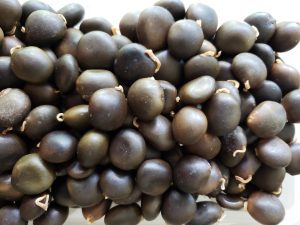
The ways in which horticulturists overcome seed dormancy depend on the type of dormancy. For seeds with impermeable seed coat, such as the Kentucky coffeetree (Gymnocladus dioicus) seen above, a technique called scarification is used. Sandpaper is used to break through the seed coat until the white cotyledon is visible. Under warm, moist conditions, these seeds will germinate. To germinate a large amount of seed, there are other ways to break the seed coat, such as using acid to “etch” holes in the seed coat to allow for water imbibition.
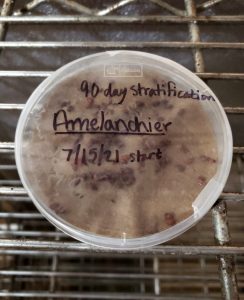
In the case of endodormancy, we usually have to be patient. Seeds are placed in a cool (38–42ºF) place under moist conditions. This process is called stratification. Depending on the plant species, stratification can take from 2 weeks to almost a year. It is as easy as putting seeds in a sealable plastic container or bag with moist media, and placing them into a refrigerator.
Dormancy is a great strategy for enhancing a plant’s survival potential because germination is delayed until a later time when environmental conditions are more favorable. However, for horticulturists who prefer that a seed germinate as quickly as possible after being planted, dormancy is a nuisance. One of a horticulturist’s important skills is to recognize dormancy, identify the dormancy mechanism, and take steps to overcome the inhibition so that plants can grow predictably from seed when planted.
Review questions:
- What external factors are required for germination?
- Outline the process through which the seed’s embryo receives useful energy from the starch stored in the cotyledon or endosperm.
- What are the factors required for successful long term seed storage? How do these compare to the factors required for germination?
- What are the different types of dormancy?
- If you knew a seed had ecodormancy, what would you do to encourage germination?
When a seed does not germinate until given proper conditions for germination (oxygen, water, temperature, and sometimes light).
Term used when seeds are alive and don't germinate when provided with favorable conditions for germination.
Internal factors within the seed prevent germination.
When external factors, usually environmental, prevent a seed from germinating.
Process used to break a physical seed dormancy (hard seed coat).
Process used to break a physiological dormancy, such as embryonic or endo/eco-dormancies.

